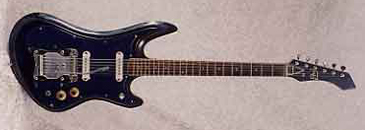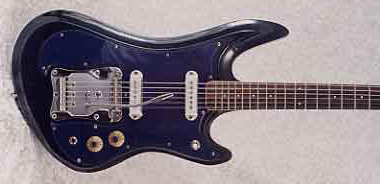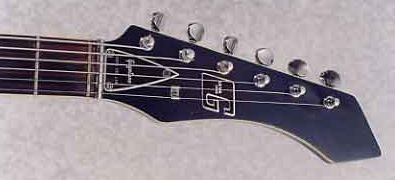Well, well, well. What have we here? On the surface, of course, it’s a 1968 Guyatone LG-350T Sharp 5. A sight little seen in North America, but not uncommon in Japan, at least once upon a time. And if it makes you think of a little bit of a Mosrite on drugs, well then you’re not too far off the mark! Welcome to a bit about the Ventures and the early world of copy guitars!

1968 Guyatone LG-350T Sharp 5 Vintage Electric Guitar
It shows my age (everything does now anyway), but around the time I was hitting my teenage years, I discovered what was then still a fairly obscure band called The Ventures and their record called Another Smash. At least they were obscure for northern Michigan. This was also about the same time that I figured out I wasn’t going to be either the next Johnny Unitas or Al Kaline (a famous slugger with the Tigers). My dream became to learn those songs, which I eventually did more or less and I still play some of them to this day. The Ventures went on to have a bunch of hits, perhaps the most famous of which was their streamlined version of Johnny Smith’s “Walk, Don’t Run.” Their popularity eventually led to a relationship with Semie Moseley and yielded the Mosrite Ventures guitars, which was literally based on a tracing of a flipped-over Strat! Plus the groovy German carve around the edge that Semie had learned from Roger Rossmeisl.
Even though the Ventures seemed to keep increasing their record output, their popularity didn’t quite keep pace. In the US, that is. At a time when Jimi Hendrix and Fresh Cream were all the rage, the Ventures just didn’t seem relevant. What saved the Ventures’ career during those lean years when they were eclipsed by Bob Dylan and the Beatles was an astonishingly virile popularity in Japan. The Japanese obsession with the band extended to everything Ventures including Mosrite guitars. By the mid-‘60s, when Japanese guitarmakers finally began to become competitive in the American market, they hit upon a strategy of imitating the competition. Which, at the time, was European guitars. Among the early Japanese imitations were the violin-bodied copies of EKO’s popular copies (of Hofner’s copies of Gibson’s…well, you get the picture).

1968 Guyatone LG-350T Sharp 5 Vintage Electric Guitar
Wholesale copying of American guitars would come later, but the honor of the first American design to be copied probably goes to the Mosrite Ventures. By 1966 or ’67 many Japanese guitarmakers were building guitars inspired by Mosrites, with extended lower horns and/or German carves and/or slanted neck pickups, etc. Among the earliest and goofier of these in Japan were these Guyatones.
Guyatone was one of the first guitar manufacturers in Japan. It was founded in 1933 by Mitsuo Matsuki and Atsuo Kaneko and began selling Hawaiian guitars with the Guya brand name. After the War, in 1951, the company switched to using the Guyatone brand. Guyatones were among the earliest Japanese electrics to come to the US, imported by Buegeleisen and Jacobson with the Kent brand name.

1968 Guyatone LG-350T Sharp 5 Vintage Electric Guitar
This 1968 Guyatone LG-350 Sharp 5 is actually kind of a flipped-over Mosrite, ironically enough! It’s hard to tell from the photos, but it’s finished in a really cool dark metallic blue color. The pickguard is also blue. Its single coil pickups are not typical of most Guyatone guitars that made it to the US. This was a pretty high-end guitar for Japan at the time. The edges aren’t exactly German carve, but they are beveled. The vibrato is a pretty interesting in-body design that emulates the feather-touch of a Mosrite. An unusual feature for the time is covered tuners, sort of like European Van Ghents. And you gotta love that headstock! This is a sweet guitar way ahead of the usual quality you find in Japanese guitars of this era.
By the time this guitar was made, other guitars closer to Mosrite were beginning to appear made by Teisco, Kawai, Firstman, Aria, Zen-On, Humming Bird, Suzuki, Minister, Audition, Monica and others. And the first near-copy had made it to America in the Noble EG 686-2HT, a variant on the Mosrite Combo, marketed by Chicago’s Strum & Drum. By the early 1970s Mosrite knock-offs had become standard, like one of the most famous, the Univox Hi Flyer. But as sharp as those are, that’s another story!

Fantastic looking guitar! Here’s a site with great detailed pictures of a primo LG-350T DX,the three pickup version,that sold for $1820 on eBay about eight months ago.Click on them to enlarge. Beautiful high quality workmanship on these guitars.I would love to hear what they sound like.
http://guitargarage.blogspot.com/2008/11/japanese-surf-mania-guyatone-lg-350t.html
You didn’t tell us how it sounds……
These were the guitars Guyatone made for the Sharp 5, which were a fantastic japanese eleki band influenced by the ventures. Nobuhiro Mine was their lead guitarist. Check them out if you can, their best albums are Haru No Umi, Classical Sensation, and Battle of the Koga Melody.
Pretty good article about Munetaka Inoue & His Sharp Five: http://radiodiffusion.wordpress.com/2008/06/24/bunnys-sharp-five/
They also have a couple of MP3s to listen to and/or download.
The Mosrite is really more of a flipped-over Jazzmaster, but I’m just picking the fly poop out of the pepper. My brother recently came up with a modern counterpart to the Guyatone called a DiPinto Galaxy 4. Silver sparkle paint, cheesy plastic switches, gumby body, gold marble pickguard, FOUR pickups, Jazzmaster trem, the works! Very George Jetson! The guys in Los Straight jackets have matching Galaxies! Unfortunately, previous owner had done some shoddy mods, so I took on the task of repairs. Removed enough excess solder to mint a silver dollar! Hideous! Plays and sounds pretty good, now! Looks great!
PLEASE MAKE THIS EASTWOOD!
a well made copy of this would be a nice option to a contemporary jaguar, and I’d certainly buy one.
http://www.youtube.com/watch?v=pygl6BXbuZk
Here is the band the guitar is named for in action with these guitars.
Eleki!